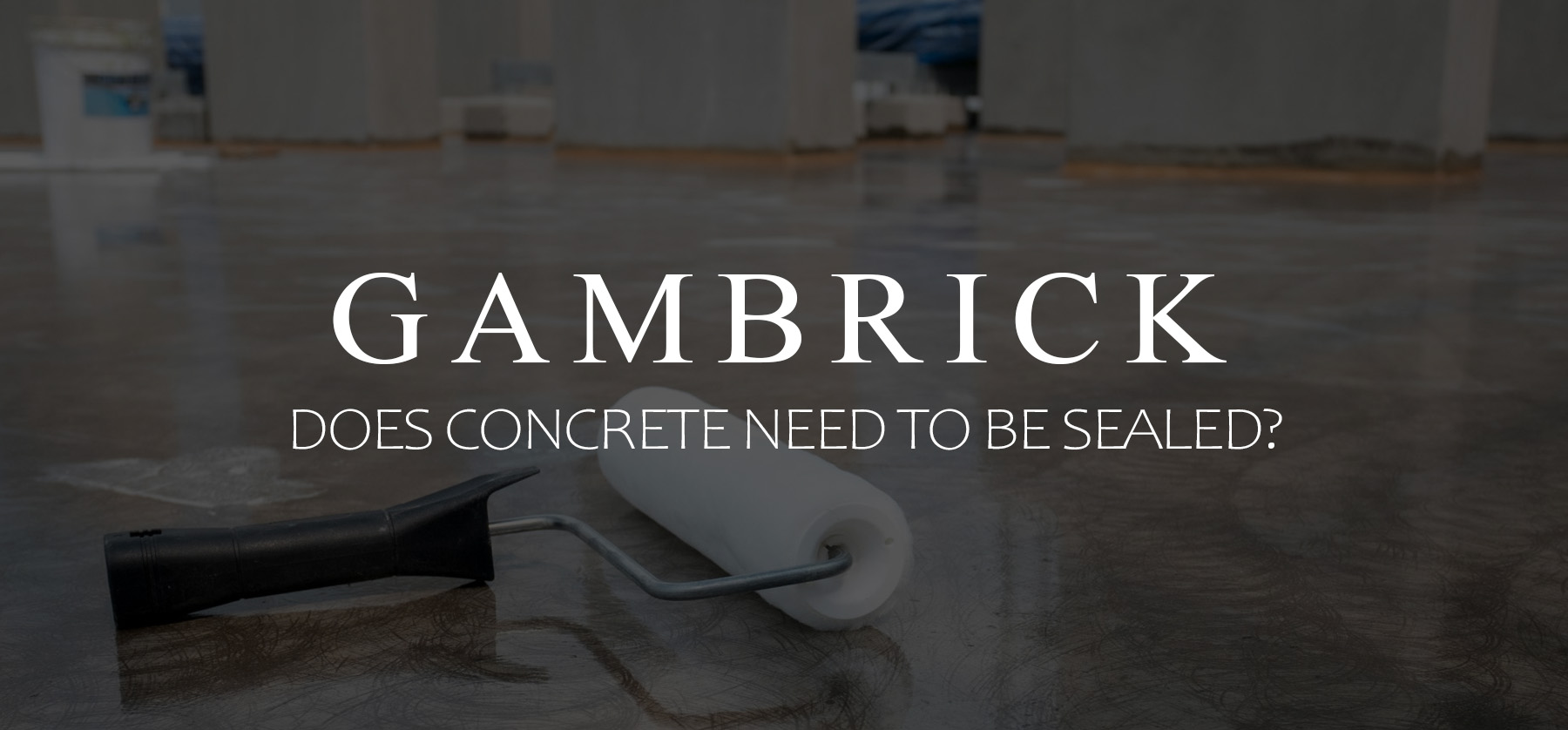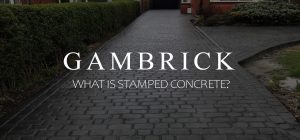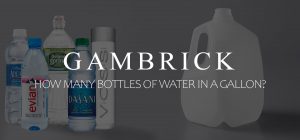
Does Concrete Need To Be Sealed?
I’ve been a mason for over 25 years and can tell you firsthand that not all concrete needs to be sealed, but in some cases it’s a huge benefit and highly recommended. Sealing things like a concrete patio or walkway is a good idea because it preserves the look and longevity of the concrete while bringing out its rich color. Sealers prevent water from absorbing into the concrete by beading it on the surface, which helps concrete last longer, especially in Winter. They can also have UV protection to prevent sun damage and fading, which is a big benefit in Summer.
Many sealers include non slip additives, which is great around a pool. When the concrete gets wet, the sealer provides a little more grip, which helps prevent slips and falls.
Sealers can even help fight stains by creating a thin layer between the spill and concrete.
Most people generally seal concrete that’s flat. Things like patios, sidewalks and walkways. But a concrete foundation typically isn’t sealed. Although a concrete wall does get wet, water doesn’t pool like it does on flatwork, so it doesn’t benefit as much from a sealant.
Sealers should be applied with a tough concrete roller and brush that won’t get chewed up by the concrete’s gritty texture.
After concrete has been poured and cured, adding a sealer helps protect it from future damage, corrosion, and stains. Because concrete is porous, it tends to absorb water and other substances. Sealing closes up pores and prevents any future freeze/thaw damage to the concrete which can result in cracks. But to get the most benefit, you must apply your sealant properly and buy the right type for your concrete.
I highly recommend sealing all your flat concrete work, especially in areas that get the most sun and water.
Why Do You Need to Seal Concrete
If you own a home or building, there’s a good chance concrete was used to build it. Concrete is one of the most common construction materials in the world. And one of the strongest. It’s used to build homes and buildings, bridges, sidewalks, patios, floors, sidewalks and so much more. If you want to preserve and protect your concrete for the long term then a good sealer can help.
While concrete is strong and durable, it’s porous and prone to cracks. Concrete can degrade due to the elements or sun damage. While it has the potential to last for generations, it can potentially weaken and break if it isn’t cared for.
The best way to protect concrete is to use a concrete sealer as soon as it’s finished curing. Without a sealer, your concrete will be more vulnerable to preventable and expensive damage. It’s a lot cheaper and easier to apply a sealer every few years then it is to repair a cracked patio.
Concrete sealers come in a variety of types. Topical sealers like acrylics are great for colored concrete because they enhance the color while protecting from sun, rain, mold and mildew. Epoxies, urethanes, and polyaspartics, are good for high traffic/high chemical risk concrete surfaces that are found in places like industrial warehouses, retail stores, bus stations and airports. There are penetrating sealers, like silicates, that chemically react and increase the concrete’s strength.
Almost every concrete sealer creates a strong moisture barrier to prevent water penetration which is a major cause of concrete damage. Because there are so many options on the market, it’s easy to choose a sealer for your particular situation.
Below we’ll look at a few types in more detail.

Sealers Protect & Enhance Concrete
Many people ask why it’s important to seal concrete. Concrete is an important part of your homes construction and a big investment. It doesn’t matter where it’s used, whether it be for a home or a retail store. It’s always cheaper in the long run to prevent damage rather than repair it.
Sealing your concrete has aesthetic appeal too. Acrylic resin based sealers enrich and enhance colors which makes them look fresh and new. A good sealer creates a top coat between the concrete’s surface and any substance that spills on it which helps prevent staining. This layer also helps stop water penetrations and sun damage which are also big causes of concrete damage.
Most sealers are even available with different levels of gloss:
- Solvent sealers give concrete a higher gloss finish.
- Water based sealers have a semi-gloss or matte finish.
- Penetrating sealers have a low or no gloss finish.
Reapplying sealers every few years will protect your concrete against common causes of damage, make it look better and save you money in the long run.
Acrylic Resins
Acrylic resin sealers are water based, affordable, and easy to apply. They can also be blended with epoxy, polyurethane, and other bases to enhance their durability.
There are two types of acrylic resin sealers:
Styrene Acrylic. Styrene is both a cure and a sealer because it resists moisture as you’re curing the concrete.
Pure Acrylic Resin. This is a higher performance sealer that doesn’t contain any additives. It does basically the same thing as Styrene but last a little longer. Although it’s a typically a bit more expensive.
Acrylic resin sealers last 1-5 years on average depending mainly on weather conditions, the concrete they’re used on and sun levels.
Epoxy or polyurethane
Epoxy and polyurethane concrete sealers are considered the more premium and high performing sealers. They boost the life span of concrete and are generally more expensive than acrylic resin sealers.
Epoxy and polyurethane sealers are mainly used for heavy duty purposes. They’re great at resisting wear and tear in high traffic areas. For example, they’re used in factories, bus stations, airports and store floors where there’s a lot of foot traffic. Some water based versions of Epoxy or Polyurethane sealers are also used on concrete countertops.
Epoxy and Polyurethane sealers can have thick layers that makes concrete a little slippery. They should applied by a Pro and sometimes mixed with a non slick agent.
These sealers typically last 1-5 years on average depending mainly on how much abuse and traffic they see.
Penetrating Sealers
Penetrating sealers are made from a few different resins:
- Silane
- Silicates
- Siliconates
- Siloxane
These sealers are all considered penetrating sealers because they penetrate into the concrete rather than sitting on top. They form a barrier that blocks out impurities and pollutants that can erode or stain concrete. They can be applied to either damp or dry surfaces.
Penetrating sealers typically last around 5 years or more and are very durable. And they can be combined with topical sealers for even more protection. They’re not generally used in residential construction.
When Should Sealer Be Applied?
The best time to use most concrete sealers is right away. I apply mine as soon as the concrete is safe enough to walk on.
Some sealers are applied after concrete has finished curing. This usually takes about 28 days. Once the curing process is finished, apply your sealer to the concrete surface.
Make sure the air and surface temperatures are above 50°F during and right after the application process.
The sealer can be applied to both interior and exterior concrete. Using a water-based sealer and sealers rated as a green product are safer for countertops where there will be lots of food and hands.
Check the label on the type of sealer your using the determine when’s the best time to apply it. For most residential projects right away is best.
When your applying sealer to concrete that’s older than 28 days, such as when you re-apply it, any time is generally fine.
How To Apply A Concrete Sealer
Most concrete sealers can be applied DIY using simple tools, such as a paint roller or sprayer. These include acrylic-resin sealers, penetrating sealers, water based, epoxies and urethanes. High performance sealers such as epoxies, polyaspartic urethanes and polyureas require professional installation using special tools and application techniques. Luckily these are aren’t typically used in residential homes.
Instructions for applying most sealers to a concrete surface is listed below. As always, take safety precautions such as wearing goggles, gloves, and ventilating the area if it’s indoors. Also, read the instructions on whatever sealer you buy before applying. The steps below are general. There may be special requirements for what you buy.
- Clean the concrete’s surface thoroughly with a broom or other cleaning tools. You don’t want to apply sealer over dust and dirt. Most sealers require the surface to be dry rather than damp.
- Remove any oil or grease. Anything you seal over will be locked in and impossible to clean without also removing the sealer.
- Fill in any cracks before applying with either new cement or flexible caulk.
- Apply your first coat of sealer with your roller or sprayer. Wait for it to dry.
- Apply the second coat. Make sure the coats are thin.
Pro Tip. Apply the sealer coats in opposite directions. By doing this you’ll hit the concrete from a different angle which may help penetrate small pores you missed the first time.
In some cases it may be necessary to remove the existing sealer. This is sometimes needed if the new sealer is a different type than the old one. If the new sealer is the same type as the old one then you can generally go right over it.
Best Concrete Sealers
Concrete sealers protect your concrete and make it look better. There’s no one single sealer that’s best for all applications. You should take the information provided here and choose a seal that works best for your articular situation.
Overall, concrete should be sealed to protect it from damage and staining. Especially if that concrete is flat work like a patio. It’s a wise investment that will save you money in the long run.
FAQ
Below are the answers to some of the most common questions we’re asked about concrete sealing.
What Concrete Surfaces Need To Be Sealed?
Exterior concrete in any region subject to freeze thaw cycles should be sealed. When water penetrates into concrete and then freezes, it can cause cracks.
In other regions, concrete should be sealed to resist stains, reduce dust and pollen buildup, prevent abrasion, resist chemical damage, lessen how slippery the concrete is when wet or to maintain or enhance an attractive appearance.
Flat work is the most susceptible to damage and the most important to seal. Things like patios and walkways or around a pool. Walls like a foundation don’t need to be sealed as much.
What Happens If You Don’t Seal Concrete?
Concrete is a porous material that easily absorbs water. In freeze thaw climates, the expansion of frozen water can crack concrete.By preventing water from penetrating into the concrete you also help prevent cracks.
Oil, salt, fertilizer, and other household chemicals can discolor and damage unsealed concrete. Concrete is also easy to stain. A good sealer prevents all this.
Wet concrete can often times be slippery. Some sealers include non slip additives which makes the concrete less slippery.
How Much Does A Sealer Cost?
Concrete sealers range in price per sq. ft. from .15 cents to over $2 just for the sealer. Then you have the cost of your application materials like paint rollers. For an average 500 sq. ft. patio you can expect to pay less than $50 for everything. Labor is extra.
In my opinion, using a sealer is well worth the expense. When you consider how much it costs to repair cracked or damaged concrete it’s a real bargain.
What Does Sealed Concrete Look Like?
That depends on the type of sealer you use.
Most chemically reactive sealers are nearly invisible because they penetrate into the concrete. Also any sealer with a flat or matte finish can’t be seen once it’s dry.
Solvent-based acrylic resin sealers and epoxies provide significant color enhancement and give concrete a glossy wet look. You can choose the amount of gloss you want and can even get it in matte.
Water-based acrylic resin sealers provide moderate color enhancement and a satin appearance.These also come in matte.
Urethanes (generally applied as topcoat over epoxy) are available in a wide range of finishes, from matte to gloss.
Many sealers can also be colored with tints which changes the look of your concrete quite a bit.
When Should Sealer Be Applied?
Most acrylic-resin sealers and certain reactive penetrating sealers (siliconates and silicates) should be applied right away. In general, as soon as it’s safe to walk on the concrete we apply the sealer.
Other reactive penetrating sealers (silanes and siloxanes) and most high-performance coatings, such as epoxies and urethanes, should only be applied after the concrete is fully cured (generally 28 days).
Almost all sealers can be applied after the concrete is 28 days old. So if your sealing or re-sealing old concrete then any time is fine.
Is Concrete Sealer A Green Product?
Because sealers protect concrete and are considered an important part of “green” building and their use can qualify for additional LEED points.
But as for the sealer itself, water-based products are generally considered the most environmentally friendly. Some solvent-based sealers can’t be sold in certain states because they contain chemicals that can run off into the water stream. But many environmentally friendly solvents are available.
It’s really up to you to make sure the sealer you apply is environmentally friendly. But as with most products, the greener the sealer the weaker it will be. Which means you’ll have to re-apply it more often. Although in my experience almost all green sealers work just as good as chemical sealers when fresh and properly applied. Tome it’s worth the extra effort to keep my concrete chemical free.
Summary: Does Concrete Need To Be Sealed?
I’ve been a mason for over 25 years and can tell you firsthand that not all concrete needs to be sealed, but in some cases it’s a huge benefit and highly recommended. Sealing things like a concrete patio or walkway is a good idea because it preserves the look and longevity of the concrete while bringing out its rich color. Sealers prevent water from absorbing into the concrete by beading it on the surface, which helps concrete last longer, especially in Winter. They can also have UV protection to prevent sun damage and fading, which is a big benefit in Summer.
Many sealers include non slip additives, which is great around a pool. When the concrete gets wet, the sealer provides a little more grip, which helps prevent slips and falls.
Sealers can even help fight stains by creating a thin layer between the spill and concrete.
Most people generally seal concrete that’s flat. Things like patios, sidewalks and walkways. But a concrete foundation typically isn’t sealed. Although a concrete wall does get wet, water doesn’t pool like it does on flatwork, so it doesn’t benefit as much from a sealant.
After concrete has been poured and cured, adding a sealer helps protect it from future damage, corrosion, and stains. Because concrete is porous, it tends to absorb water and other substances. Sealing closes up pores and prevents any future freeze/thaw damage to the concrete which can result in cracks. But to get the most benefit, you must apply your sealant properly and buy the right type for your concrete.
I highly recommend sealing all your flat concrete work, especially in areas that get the most sun and water.
If you have any questions or comments email us any time. We’d love to hear from you.

John Mazzuca | About | More Posts |
Custom Home Builder
John Mazzuca is a custom home designer and builder at Gambrick with over 25 years experience in the construction industry. John has designed, built and/or remodeled hundreds of homes, small buildings, and commercial projects. He writes about business, real estate, home building, and household electronics. His work has been featured in Fox Business, Better Homes & Garden, House Beautiful, and more.




















